One day during my stay in Kragujevac in March 2024, I set aside the late afternoon to take a stroll and visit some cultural monuments that seemed a bit further from the city centre. Of course, nothing was truly far, but I had limited daylight and was going on foot, so I was concerned about seeing everything I wanted. I managed to see some things and missed others, but I had the opportunity to revisit this part of the city, so in the end, everything worked out fine.
First, I went to the Lepenica River and to “Arch Bridge No. 2 over the Lepenica in Kragujevac” (the official name from the documentation I used), also known as the Lower Bridge, which is a cultural monument.
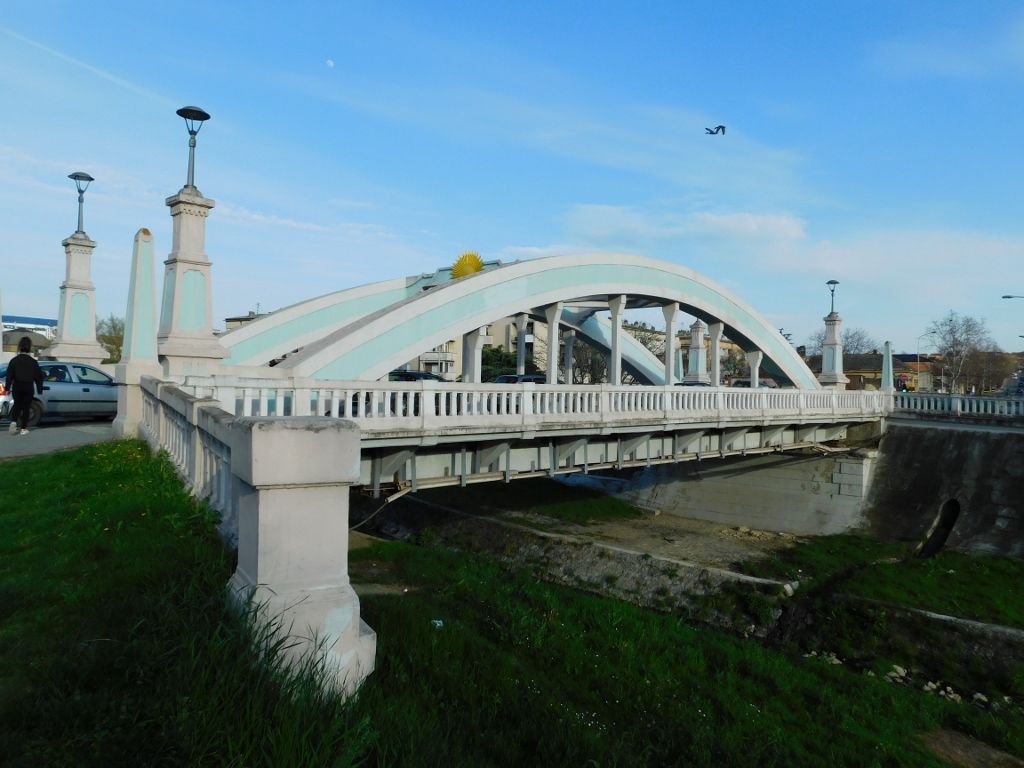 Arch Bridge No. 2 over the Lepenica in Kragujevac
Arch Bridge No. 2 over the Lepenica in Kragujevac
Back in the day, at this location stood the Stone Bridge, built by the Turks, which connected two parts of the town. This stone bridge was heavily damaged during the floods of 1896. Two years later, an iron bridge was erected, which was demolished by Austro-Hungarian troops during their retreat from Kragujevac in 1918. Therefore, in 1921, construction began on the bridge that can be seen here today, completed in 1923.
It was built in tandem with Arch Bridge No. 1, located slightly upstream, which I visited later. Both bridges are made of reinforced concrete, with a span of 30 metres and an arch. Each has a width of 11.65 meters, with the roadway being 6.2 meters wide and pedestrian paths on the sides. However, Arch Bridge No. 1 is now exclusively for pedestrians, while Arch Bridge No. 2 is used by vehicles as well. These bridges certainly belong to another era, but they seem harmonious and have their own charm.
 Arch Bridge No. 2 over the Lepenica in Kragujevac
Arch Bridge No. 2 over the Lepenica in Kragujevac
After crossing Arch Bridge No. 2 onto the right bank of the Lepenica River, you immediately come across a small square named Trg Jovana Ristića (Jovan Ristić Square), where a monument to this renowned Serbian statesman and diplomat has been erected.
 Monument to Jovan Ristić
Monument to Jovan Ristić
Jovan Ristić (1831-1899) was born in Kragujevac. What particularly stands out on his monument, specifically on its pedestal, is Article 34 of the Treaty of Berlin of 13 July 1878, through which Serbia finally gained its complete independence from Turkey. The reason for highlighting this article on the monument’s pedestal is that Jovan Ristić represented the Principality of Serbia at the Congress of Berlin.
From there, I had about 10 more minutes of walking until I reached the next cultural monument, which is the building of the railway station in Kragujevac.
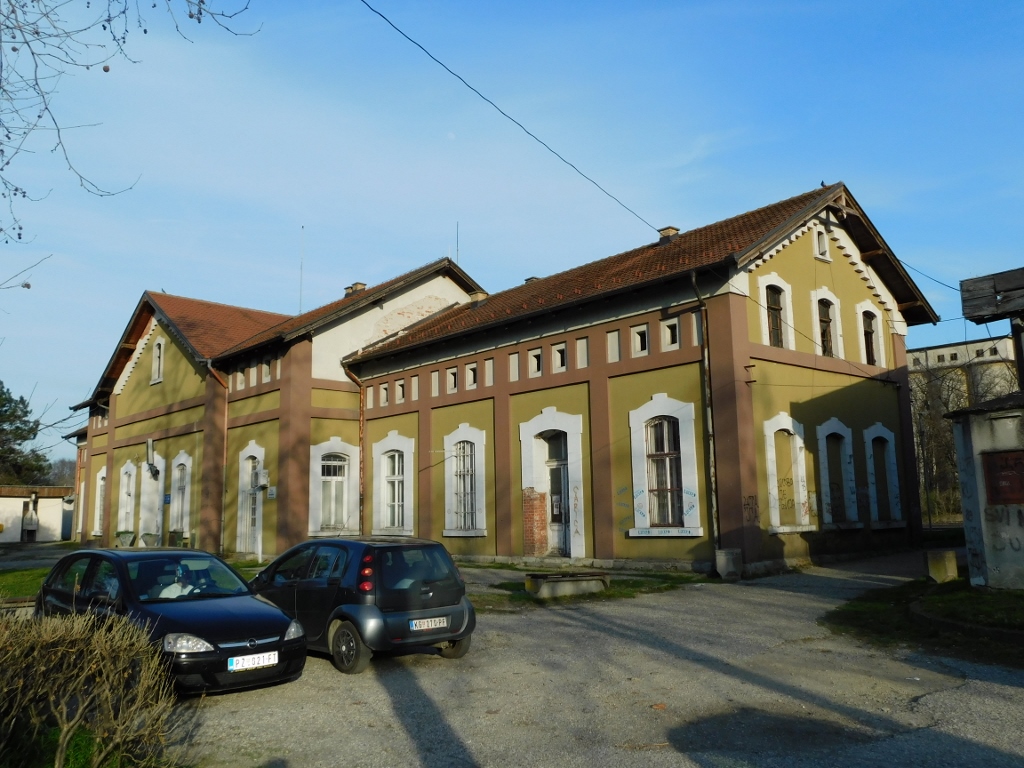 Building of the railway station in Kragujevac
Building of the railway station in Kragujevac
The building was made in 1886 during the construction of the railway line from Kragujevac to Lapovo. The design of the station was in line with European trends and standards for railway stations, using sturdy materials and adorned with beautiful decorations. Originally, it had an upper floor, but this was demolished in a 20th-century earthquake.
Although considered a well-preserved example of Serbian architecture from the late 19th century, railway traffic through Kragujevac has significantly declined over time and the building now appears somewhat neglected. I was just pondering whether trains still passed through here when, at the rear of the building where the platform is located, I noticed a passenger patiently awaiting her transport.
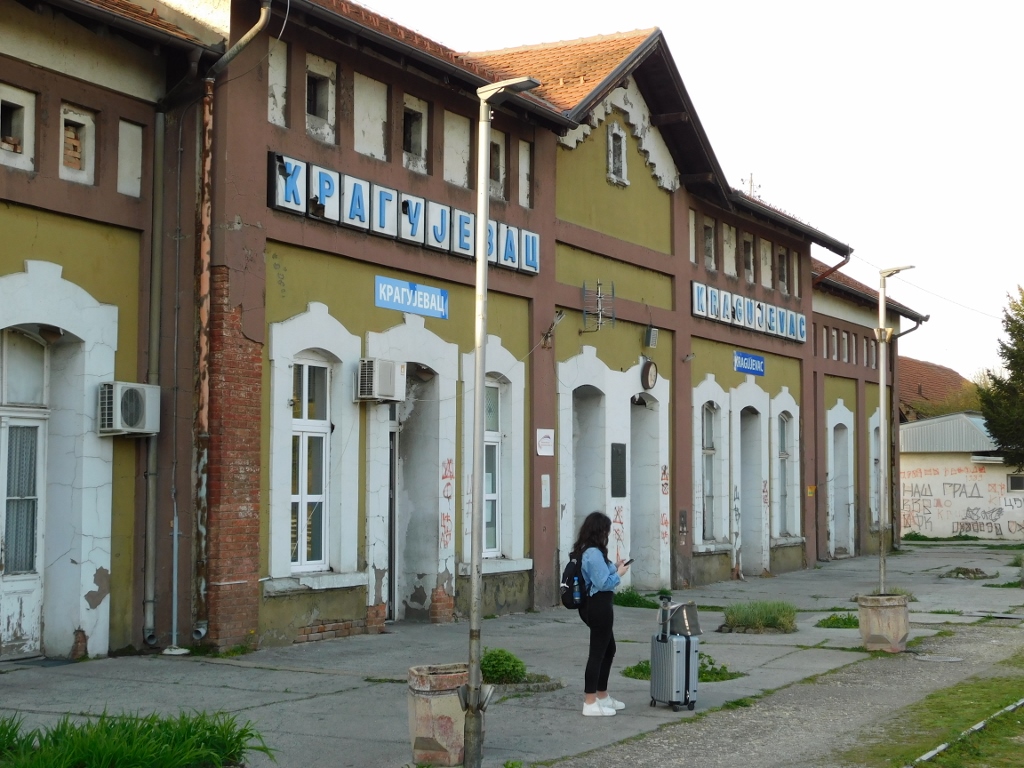 Building of the railway station in Kragujevac
Building of the railway station in Kragujevac
If the building of the railway station in Kragujevac appears neglected, what can be said about the next cultural monument I went to see? It was the water tower in Kragujevac, located a bit further from the railway station and on the other side of the tracks.
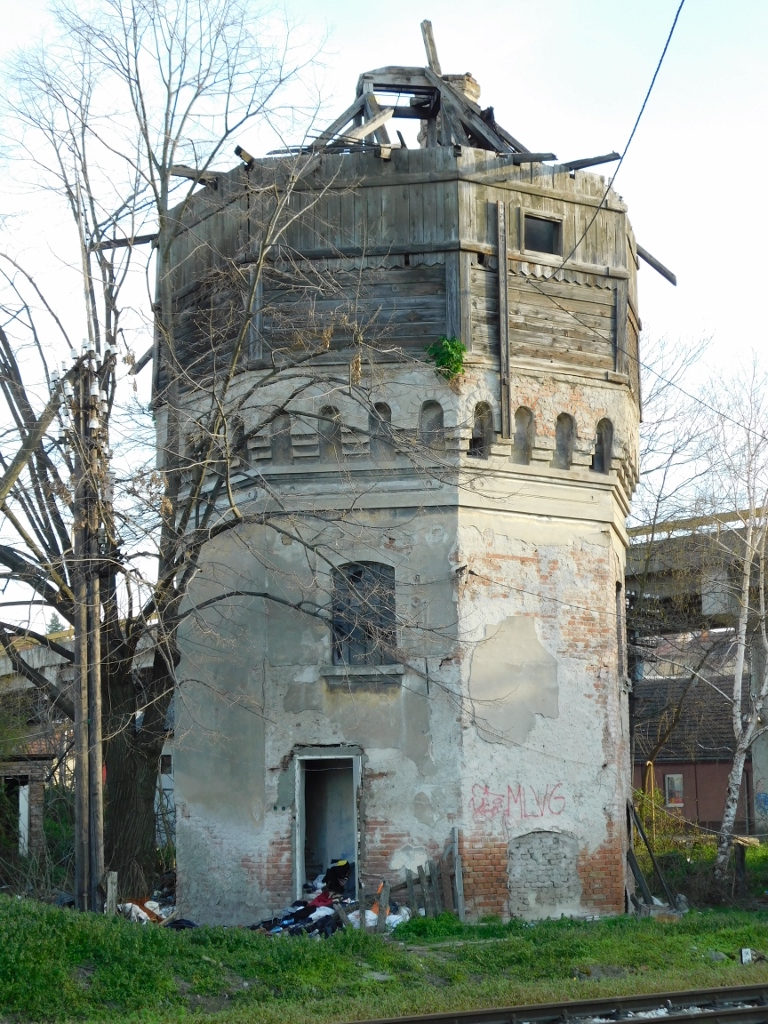 Water tower in Kragujevac
Water tower in Kragujevac
This structure was built at the end of the 19th century specifically to meet the needs of the railway, as locomotives were supplied with water by gravity from the water tower.
The base of the water tower is octagonal, constructed from brick reinforced with steel rings. At the top sits a reservoir of hemispherical shape, also made of brick but coated with cement. Below the reservoir, there is space for service operations and a furnace for heating water. A chimney was erected on the external side for this furnace, which can be better seen in the next photograph.
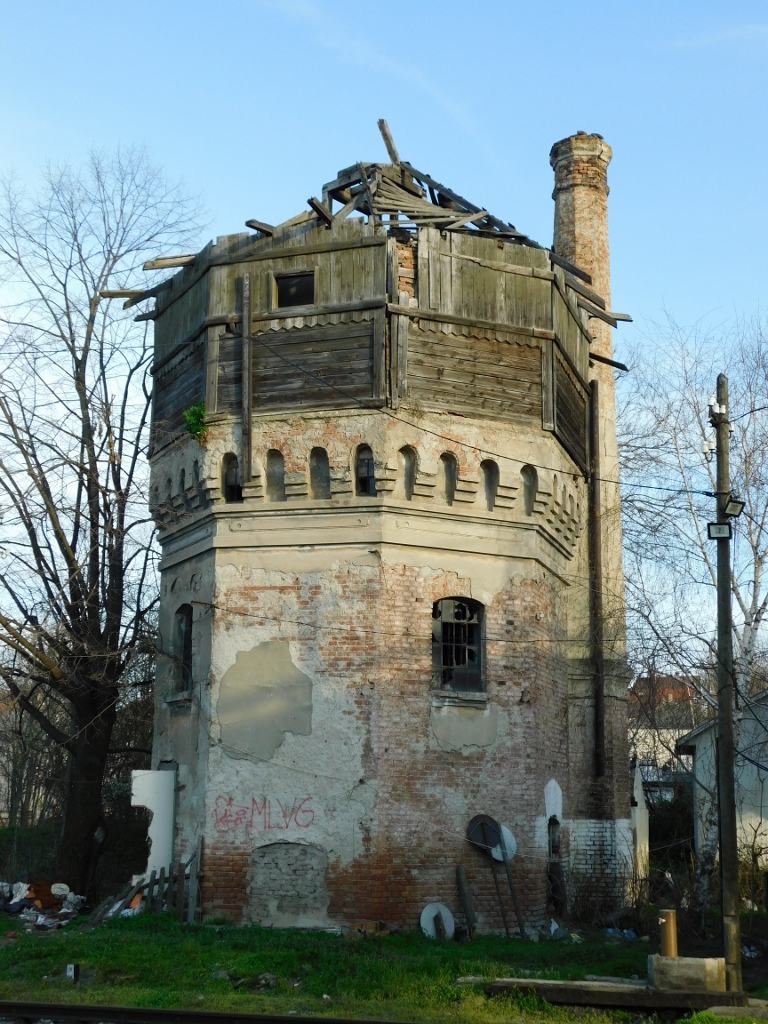 Water tower in Kragujevac
Water tower in Kragujevac
The top of the water tower is accessed via a spiral staircase located inside, running along the external walls. The upper structure was built as a half-timber construction with a tin roof, topped by an octagonal lantern. I even saw in the documentation what it used to look like (and it was magnificent). However, over time, the roof has collapsed and the condition of the entire structure is now shameful. This is one of the few preserved structures of its kind in Serbia and should represent a symbol of architectural and transportation progress and development from the past.
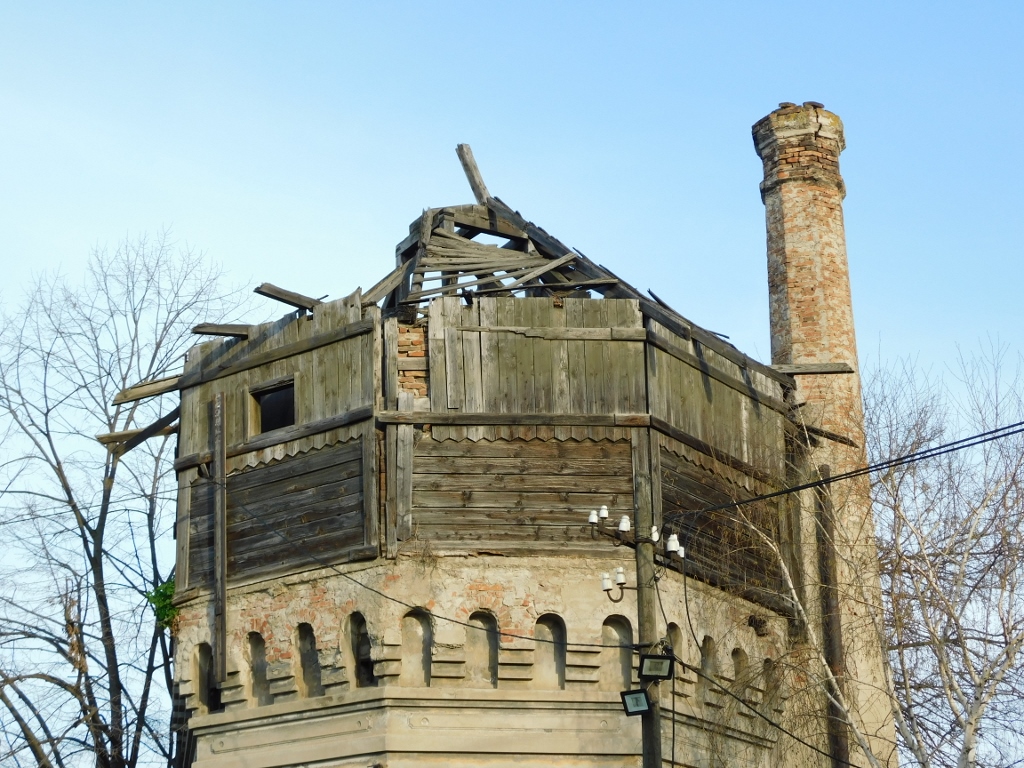 Water tower in Kragujevac, a detail
Water tower in Kragujevac, a detail
From there, I planned to return to the Lepenica River and for this purpose I followed Google Maps. However, along the way, I encountered an exceptionally kind man, so I wisely asked him the best and easiest way to reach my destination. Of course, he guided me on a much better route than the one my mobile phone was showing me.
First, I strolled along a street that follows the course of the Lepenica River and this led me to “Arch Bridge No. 1 over the Lepenica in Kragujevac” (the official name from the documentation I used). Since this bridge is upstream from Bridge No. 2, it is also known as the Upper Bridge. It, too, is a cultural monument.
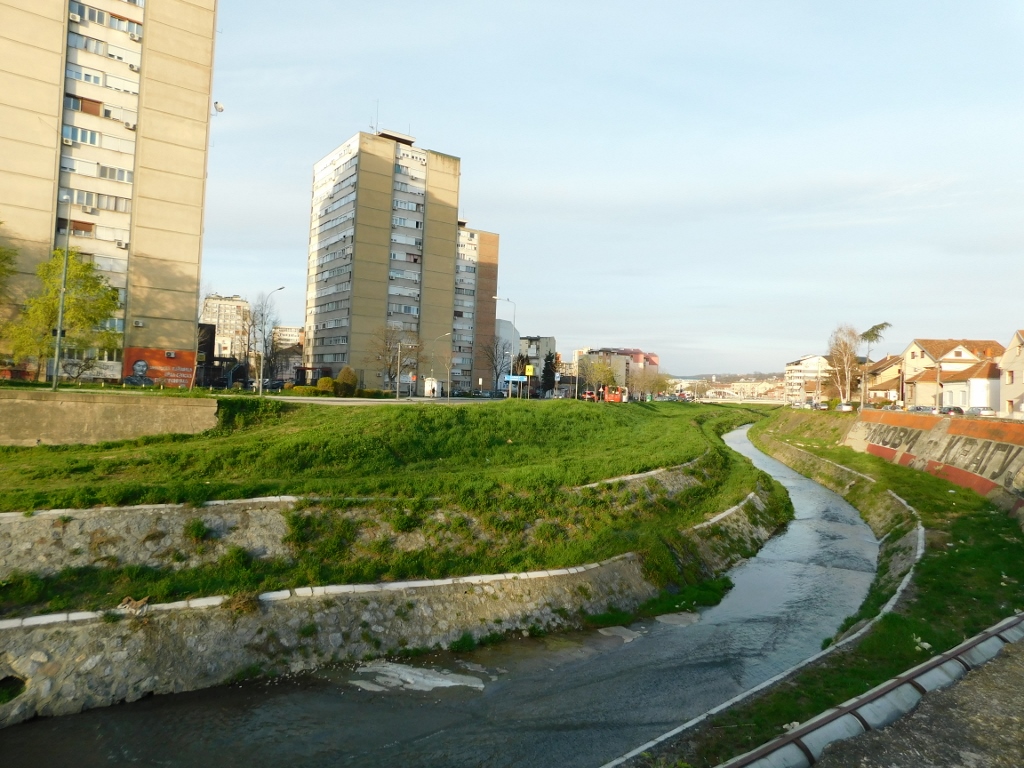 The Lepenica in Kragujevac
The Lepenica in Kragujevac
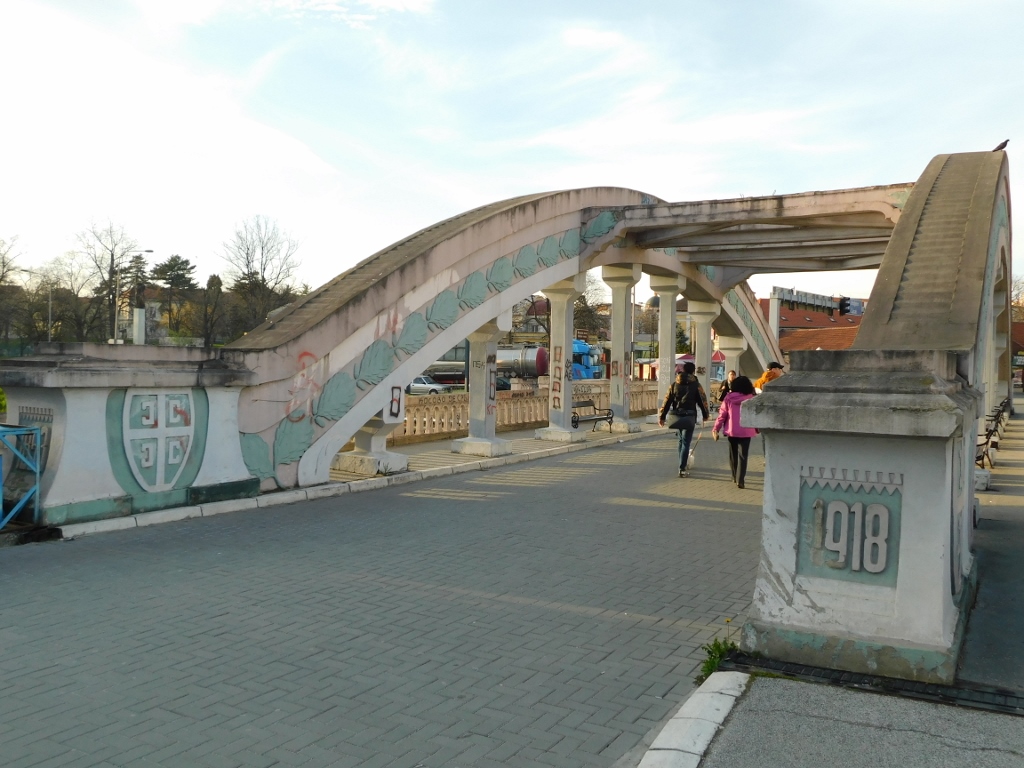 Arch Bridge No. 1 over the Lepenica in Kragujevac
Arch Bridge No. 1 over the Lepenica in Kragujevac
As I’ve mentioned earlier, this bridge was also built between 1921 and 1923, and it is now exclusively used for pedestrians. Arch Bridge No. 2 features harmonious ornamentation, while significant historical years are inscribed on the approach fronts of the bridge arches.
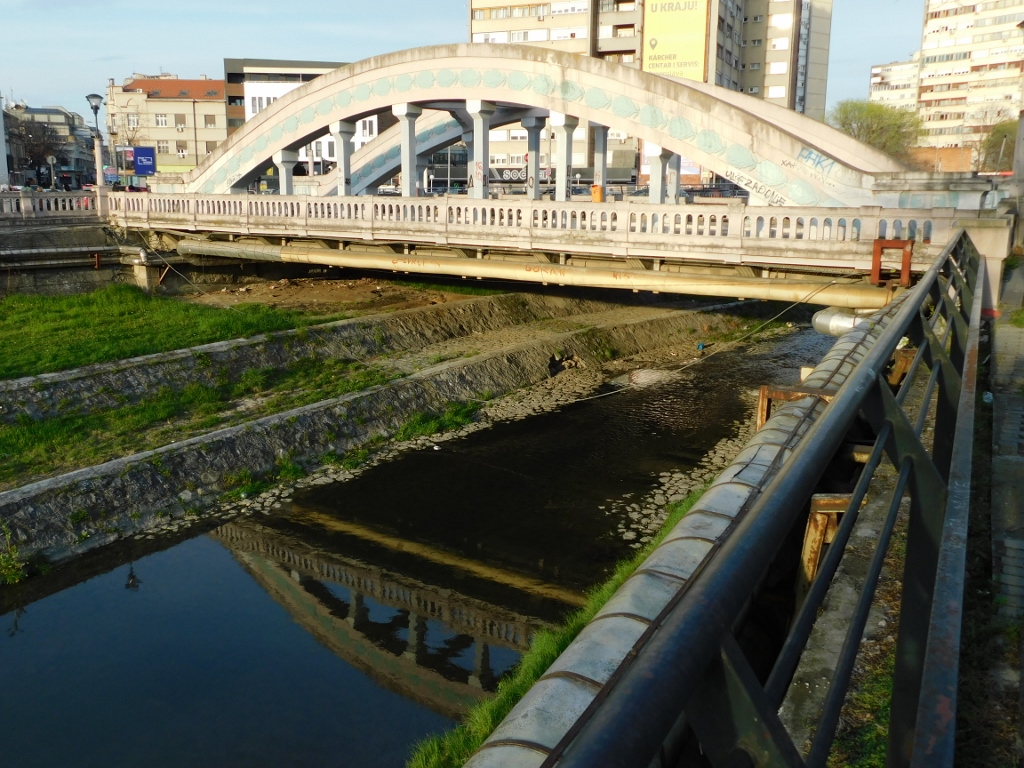 Arch Bridge No. 1 over the Lepenica in Kragujevac
Arch Bridge No. 1 over the Lepenica in Kragujevac
Since I’m talking about bridges, not far upstream from Arch Bridge No. 1, there is another bridge that is also a cultural monument. It is the Concrete Pedestrian Bridge over the Lepenica River.
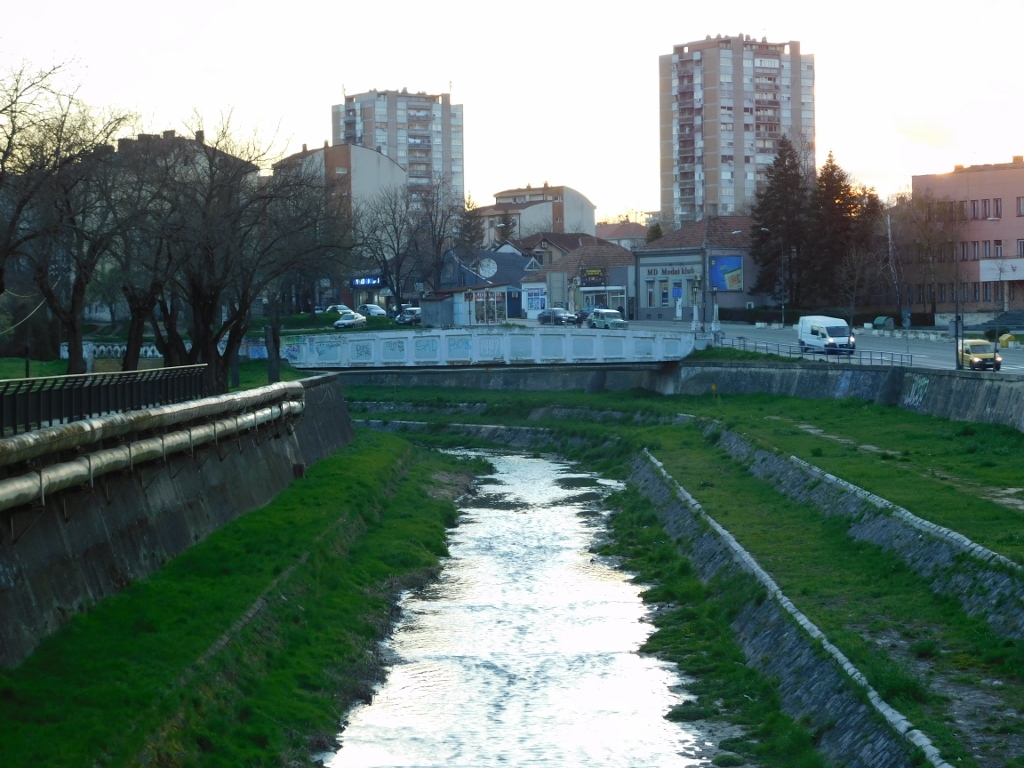 Concrete Pedestrian Bridge over the Lepenica
Concrete Pedestrian Bridge over the Lepenica
The bridge was built in 1927 solely for pedestrian use. In the first half of the 19th century, a wooden bridge stood at this location, originally intended to facilitate connections between Prince Miloš’s house on the left bank of the river and the Old Church and Assembly on the right bank. As times changed, so did the bridges and about a hundred years later, this bridge, which still stands today, was constructed. It spans 34.32 meters in length and the construction year is visible in the middle of its sides. Ornamental lanterns decorate the ends of the bridge.
 Concrete Pedestrian Bridge over the Lepenica
Concrete Pedestrian Bridge over the Lepenica
Continuing further beside the main street along the left bank of the Lepenica River towards the west, you soon come across another cultural monument listed in the documentation as the “House at JNA Street No. 11.” Of course, since JNA stands for the Yugoslav People’s Army, the street name has long been changed to Kneza Mihaila and the house is now at number 13. Again, this is an old house from the first half of the 19th century.
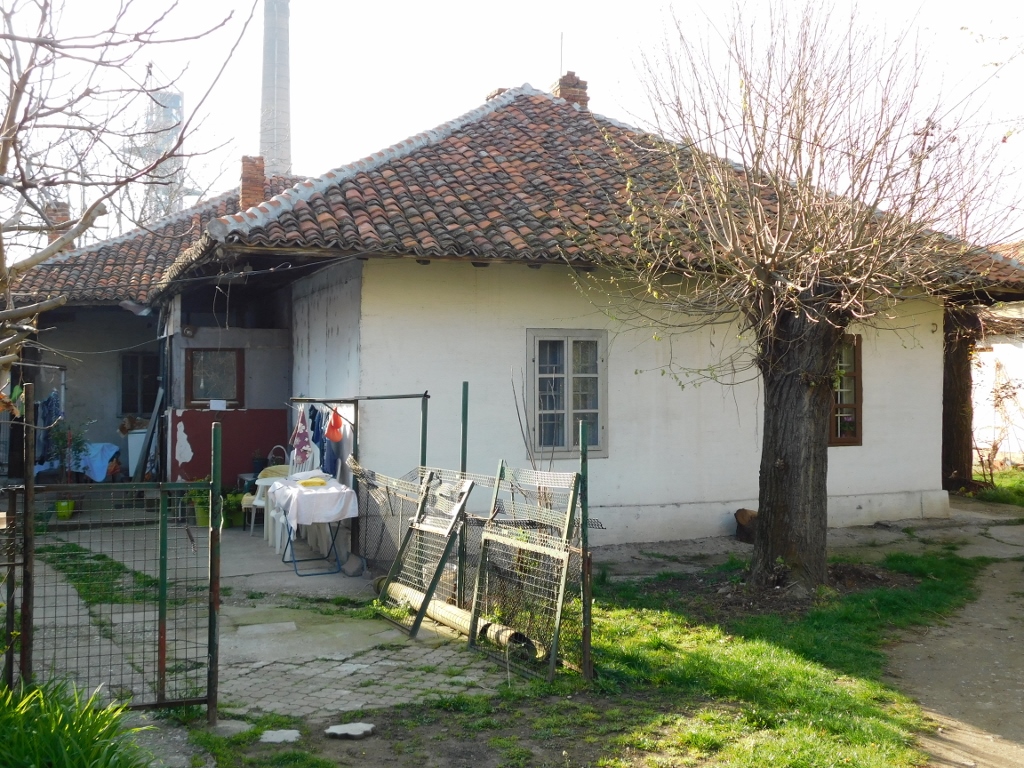 “House at JNA Street No. 11” which is in fact at Kneza Mihaila 13
“House at JNA Street No. 11” which is in fact at Kneza Mihaila 13
The house naturally reflected its time, showing elements of traditional architecture as well as influences from the East. However, what particularly interested me about this house is that it was practically commissioned by Prince Miloš. He instructed two of his associates to build houses in opposite parts relative to the area of the capital where he had his court, thus laying the urban planning foundations of old Kragujevac in a certain way.
I’ll discuss the visit to the complex where the remains of Miloš’s court in Kragujevac are located a bit later. For now, I’ll go back with my story to Arch Bridge No. 1 over the Lepenica River.
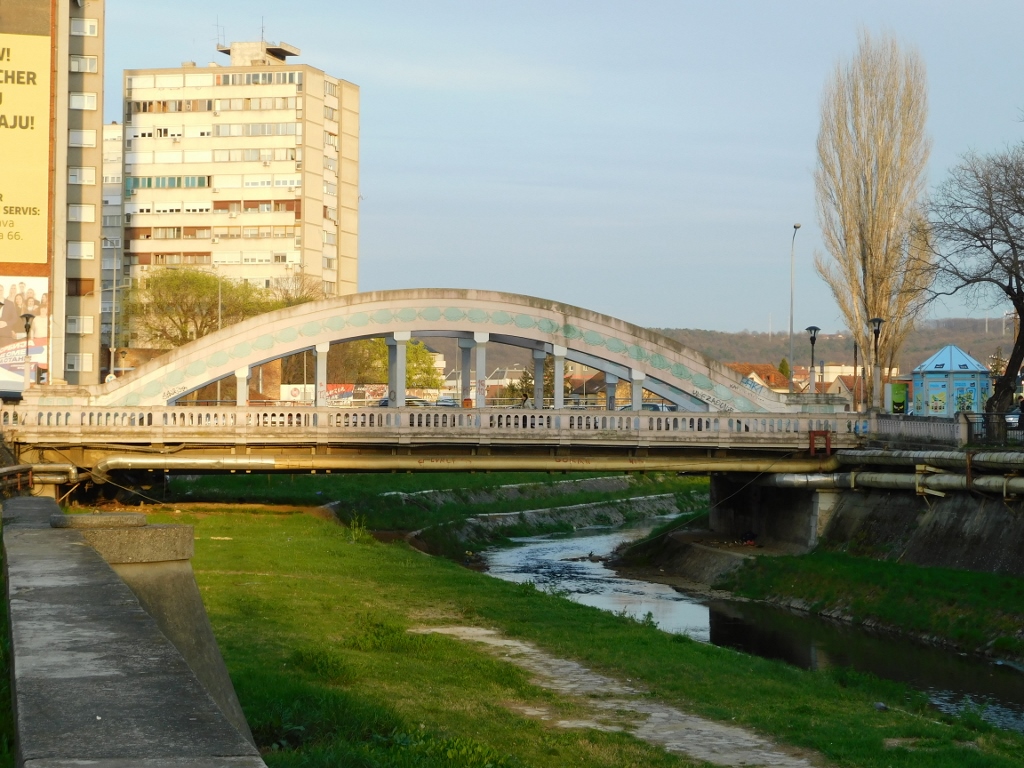 Arch Bridge No. 1 over the Lepenica in Kragujevac
Arch Bridge No. 1 over the Lepenica in Kragujevac
During my stay in Kragujevac, I crossed Arch Bridge No. 1 over the Lepenica River several times in order to reach the right bank where several important cultural monuments are located. To start with, there is also a promenade here.
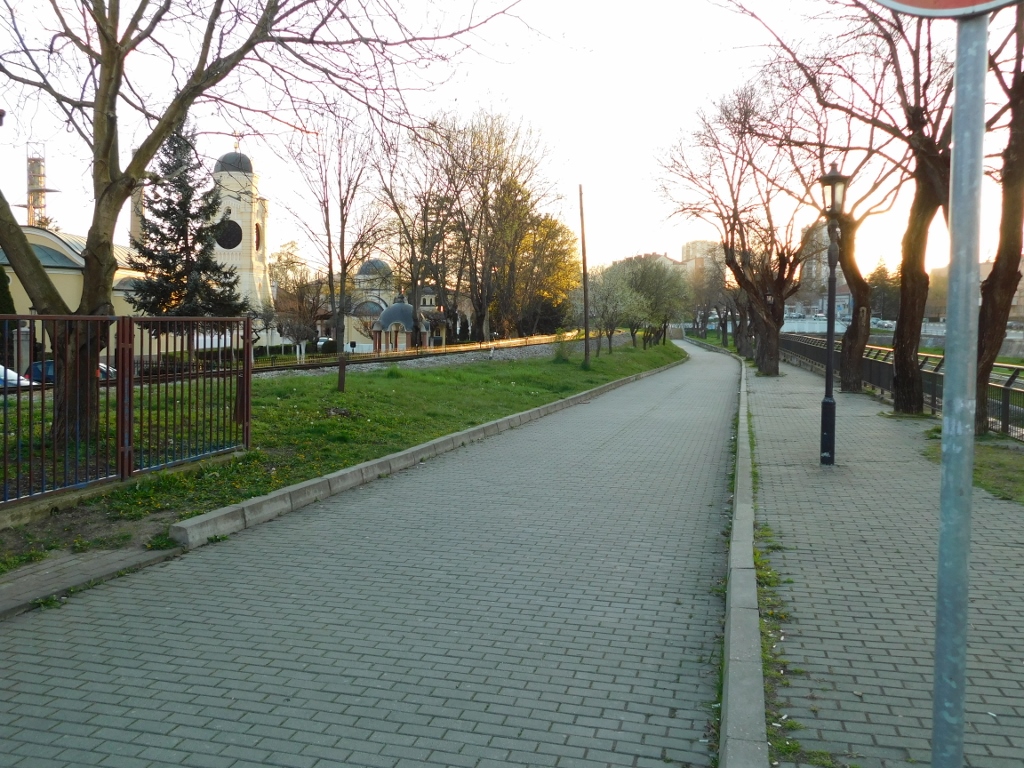 Promenade along the right bank of the Lepenica
Promenade along the right bank of the Lepenica
In the previous image, a part of a significant cultural monument can be seen, but it is important to note that on the right bank of the Lepenica River in Kragujevac, there is a large industrial complex. Some parts of it are still operational today, while others are remnants of former factories. Immediately after crossing Arch Bridge No. 1, you come across the building of the company “Zastava oružje” (Zastava Arms) where both civilian and military programmes are produced. The presence of such a company here primarily reflects the historical fact that Kragujevac was once a smaller city but a highly significant industrial centre. Nowadays, most new factories and facilities are understandably located farther from the city centre, but this site remains a vestige of earlier circumstances.
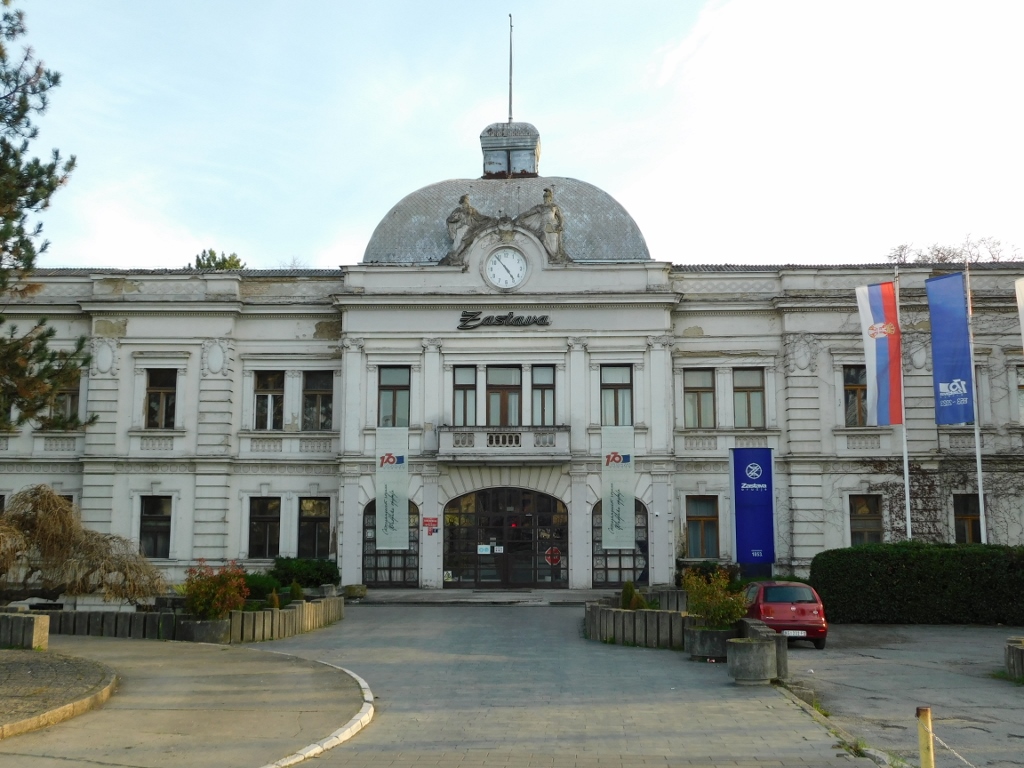 Administrative building of the “Zastava oružje” company
Administrative building of the “Zastava oružje” company
Between Arch Bridge No. 1 and the “Zastava oružje” building, there is the promenade, railway tracks and a parking lot that provides access to a complex encompassing two historically significant buildings classified as immovable cultural property of great importance. These are the Old Church and the Old Assembly Building. First, you come across the Old Church.
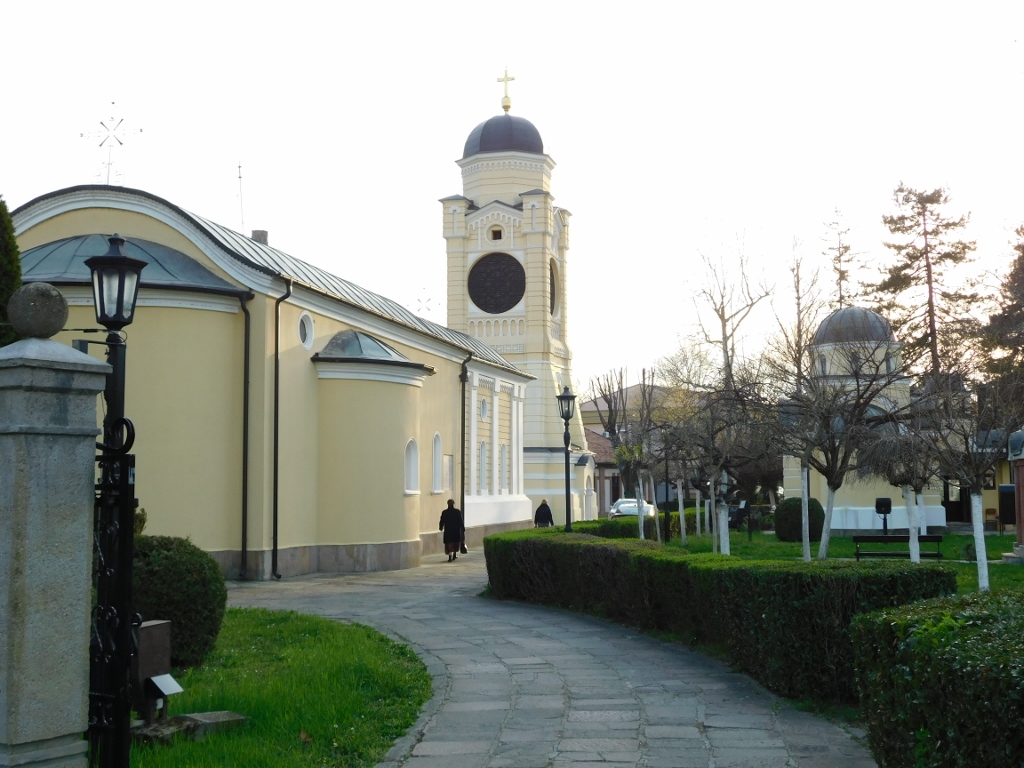 Old Church
Old Church
When Prince Miloš (born around 1780 or 1783, reigned 1817-1839 and 1858-1860) designated Kragujevac as the capital of Serbia (from 1818 to 1841), there was a need for an important court church in the city. Thus, Prince Miloš himself was the founder (the ktetor) of this church, known as the Old Church, the Church of the Holy Trinity, the Church of the Descent of the Holy Spirit upon the Apostles and also Miloš’s Church. As I’ve mentioned earlier, the wooden bridge at the site of the current concrete bridge served to connect this church with Prince Miloš’s court on the opposite bank of the Lepenica River. This endowment by Miloš was built in 1818 and today, it is not only the oldest church, but also the oldest building in Kragujevac.
However, it is important to note that Serbia did not have full independence from the Ottoman Empire at the time of the church’s construction. Therefore, the church was built as a smaller structure than Miloš apparently initially envisioned because, as I’ve read, the Turkish Sultan did not permit a Christian place of worship to be larger than the then imperial mosque in Kragujevac. On the other hand, Prince Miloš was known as a cunning and skilful ruler. He cleverly added a larger wooden porch on the western side, which served as a “women's church,” effectively enlarging the church without offending the Turkish ruler. In 1907, during the reign of King Peter I Karađorđević and Metropolitan Dimitrije, instead of the wooden porch, a section was added that connected to the church as a narthex, creating a unique space. This part of the church, with its facade adorned with white pilasters, remains distinctive today.
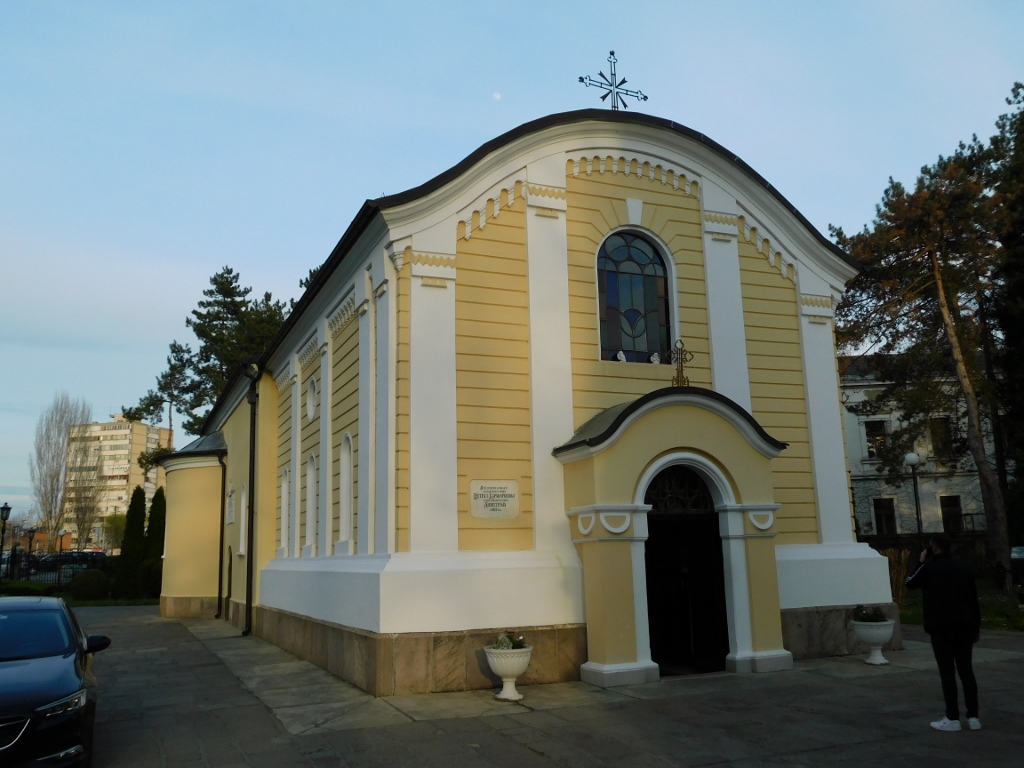 Old Church
Old Church
Across from the entrance to the church, a bell tower was erected and it first tolled in 1829, making this the first church bells in Miloš’s Serbia. The original bell tower gradually deteriorated and in 1897, a new one was built in its place.
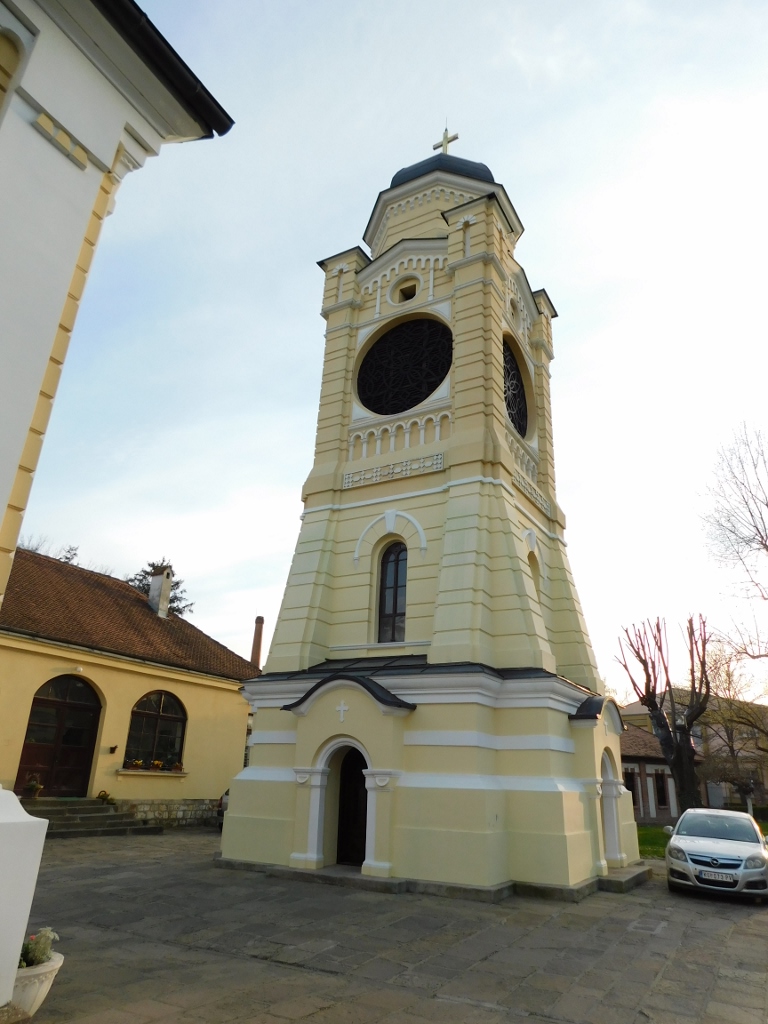 Old Church
Old Church
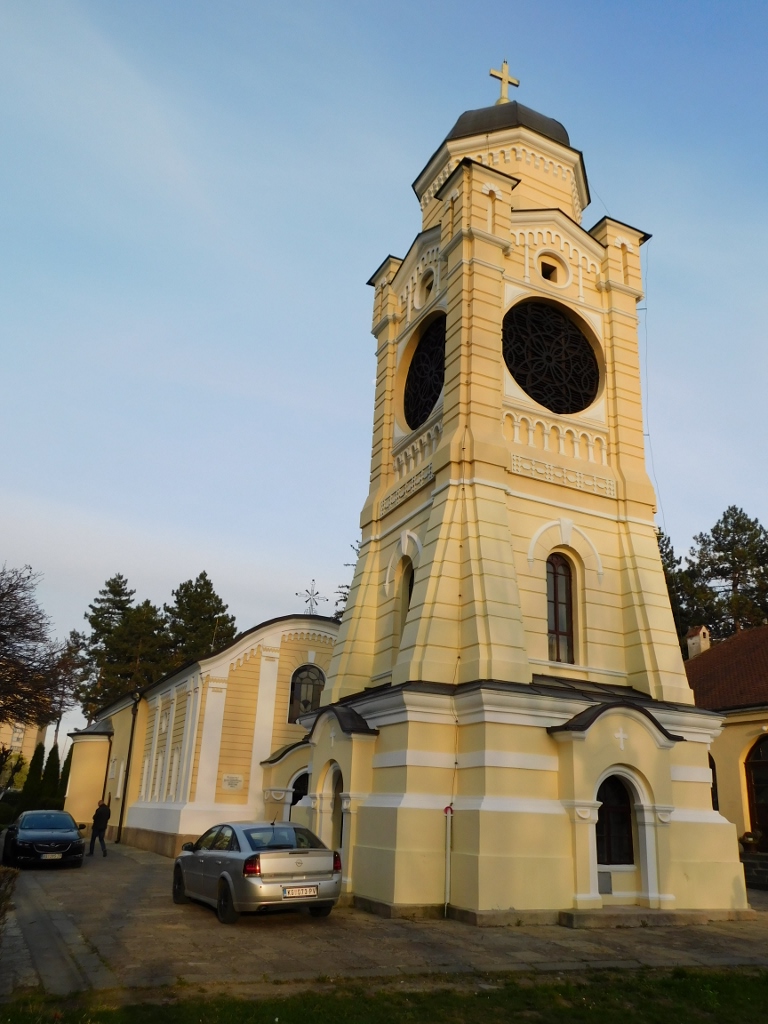 Old Church
Old Church
The interior of the church was wall-painted in the recent times.
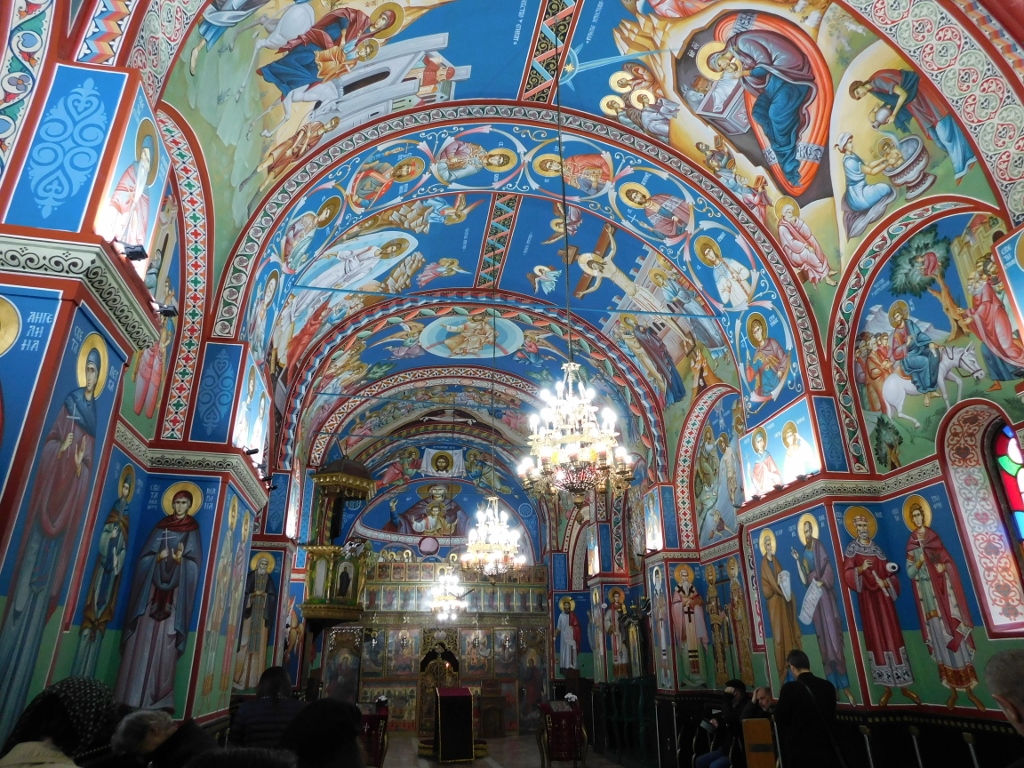 Old Church, the interior
Old Church, the interior
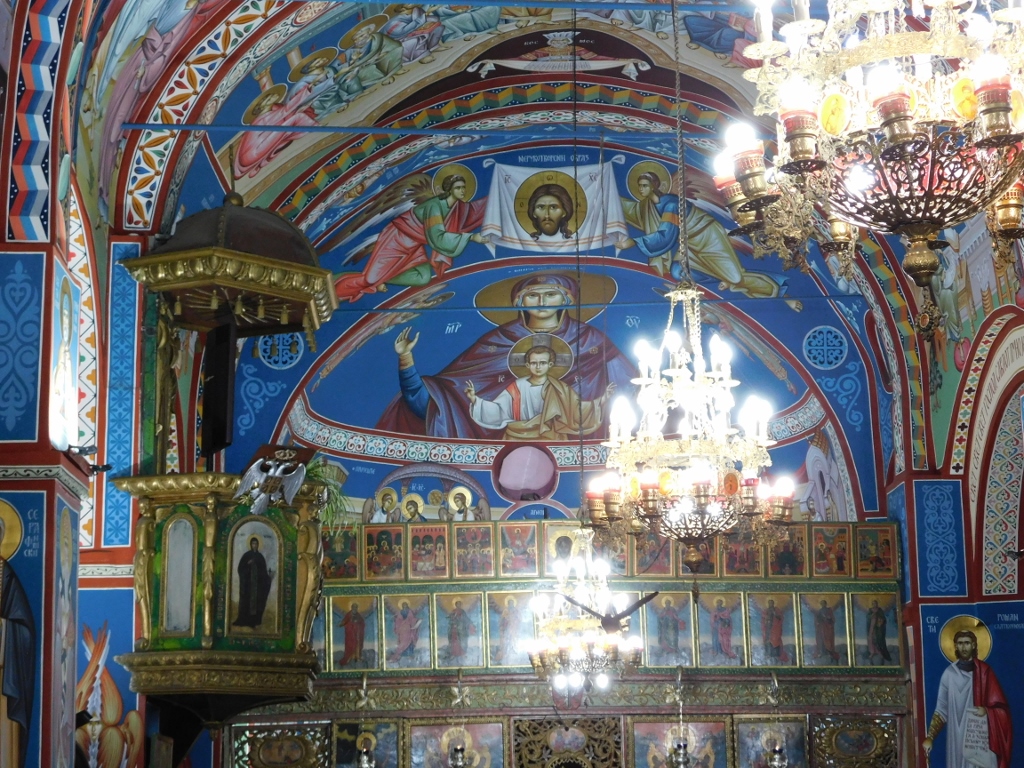 Old Church, the interior
Old Church, the interior
The courtyard of the Old Church holds significant importance as it includes the Old Assembly Building, forming a unique historical complex together with the church.
Initially, as Serbia gradually liberated itself from the Ottoman rule, national representatives gathered in the churchyard where speeches were delivered. The first regular assembly was held in 1824. Shortly after, a wooden building was constructed for this purpose. It wasn’t until 1859 that the current building was erected, which has undergone significant changes over time but remains quite similar to its original form as seen today.
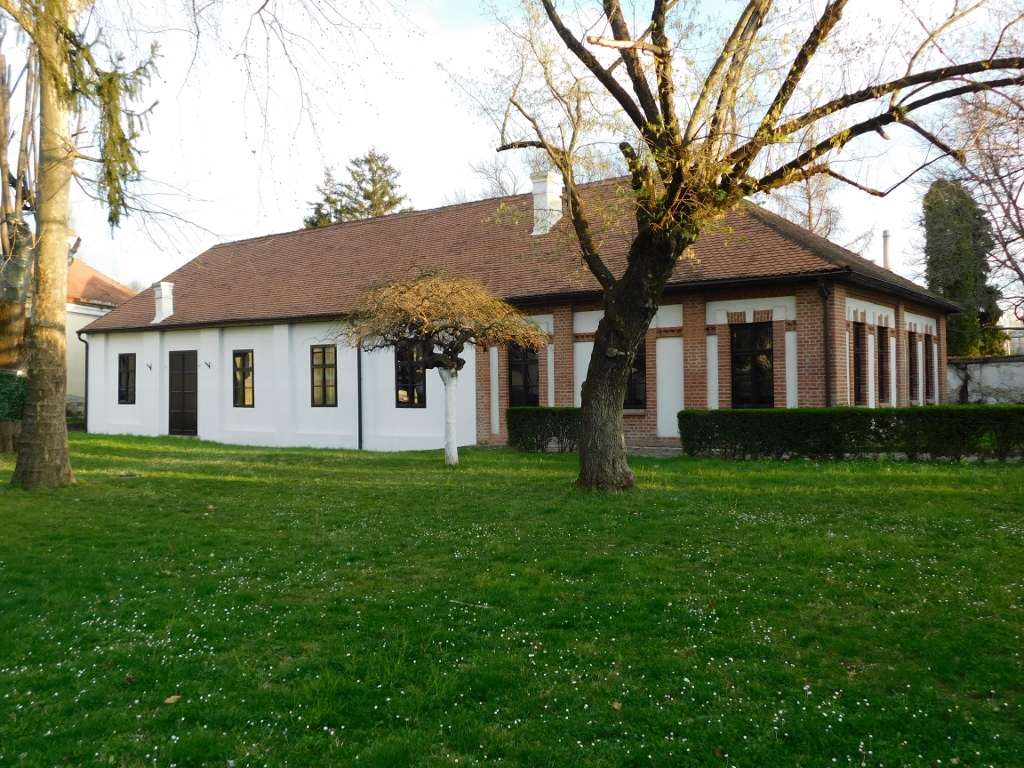 Old Assembly Building
Old Assembly Building
The Old Assembly Building is a simple ground-floor rectangular structure with minimal decoration. However, its modest appearance belies its immense historical significance for the Serbian people. In 1835, the so-called Candlemas Constitution, Serbia’s first constitution, was proclaimed here. Additionally, on 14 July, 1878, the decisions of the Congress of Berlin were read here, including crucial articles of the Berlin Treaty that finally granted Serbia’s independence after nearly 500 years of the Ottoman rule (since the Battle of Kosovo in 1389) and decades of uprisings and wars against the Ottomans (from 1804 to 1878).
Today, the Old Assembly Building houses a museum exhibition. However, like many museums in Kragujevac, the visiting hours are highly inconvenient (from what I’ve read, only twice a week for three hours each time, and only on weekdays during working hours).
Behind the Old Assembly Building stretches the complex of the Military and Technical Institute, which is also known as the Knežev arsenal (Prince’s Arsenal). This area forms a distinct spatial cultural-historical ensemble and is classified as immovable cultural heritage of exceptional importance.
It’s a unique military-industrial and architectural complex comprising numerous factory buildings and workshops from the late 19th and early 20th centuries. This complex for decades housed Serbia’s largest industrial enterprise. Unfortunately, because of the geographical position and history of Serbia, the fate made sure that the industrial development of the country should be linked to the military industry, but that’s what it is.
The foundation for this development was the old Miloš’s Arsenal, hence the name Prince’s Arsenal. Notably, Serbia’s first electric light bulb was installed here in 1884, followed soon after by the first electric machine.
Today, the complex includes a total of 151 buildings, some of which are considered particularly valuable. Many of these buildings have also changed their functions over time, but I was particularly impressed by the fact that some buildings were intended for non-manufacturing or every-day purposes, such as a crafts school, a school dormitory, the director’s residence, officers’ quarters, an old clinic and even a kindergarten.
Precisely because of this link between the industry and the city, both developed. On the one hand, Kragujevac’s central location within the country (even before the Balkan Wars and World War I) made it a suitable choice for industrial development. On the other hand, the need for labour, skilled craftsmen and engineers led to the development of residential areas in the city and all necessary auxiliary facilities.
I got the impression that much of this historical industrial complex is no longer operational, while the factories that are still functioning are somewhere “behind” and not visible in my photos. From what is accessible, the next photo shows a smaller building in very poor condition and I don't know what it was used for. However, I included it here in order to show how close this is to the Old Church, since you can see the church tower in the background.
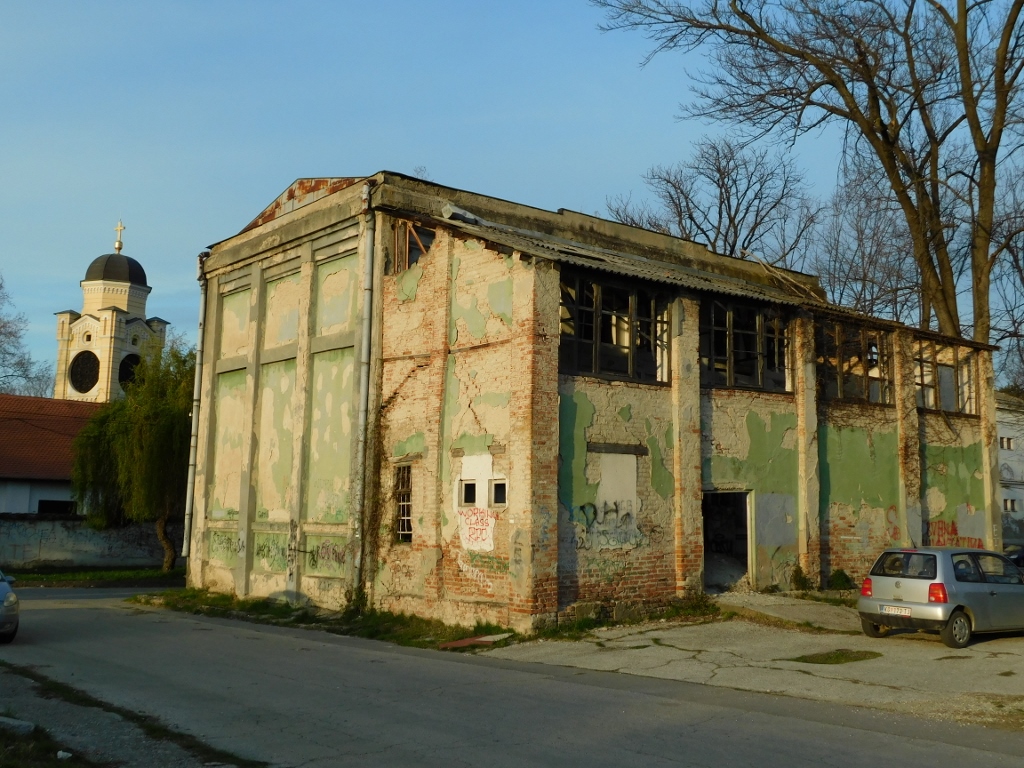 Military and technical institute complex
Military and technical institute complex
The specific industrial architecture is characterised by the use of red bricks, broken tile roofs, tall chimneys, etc.
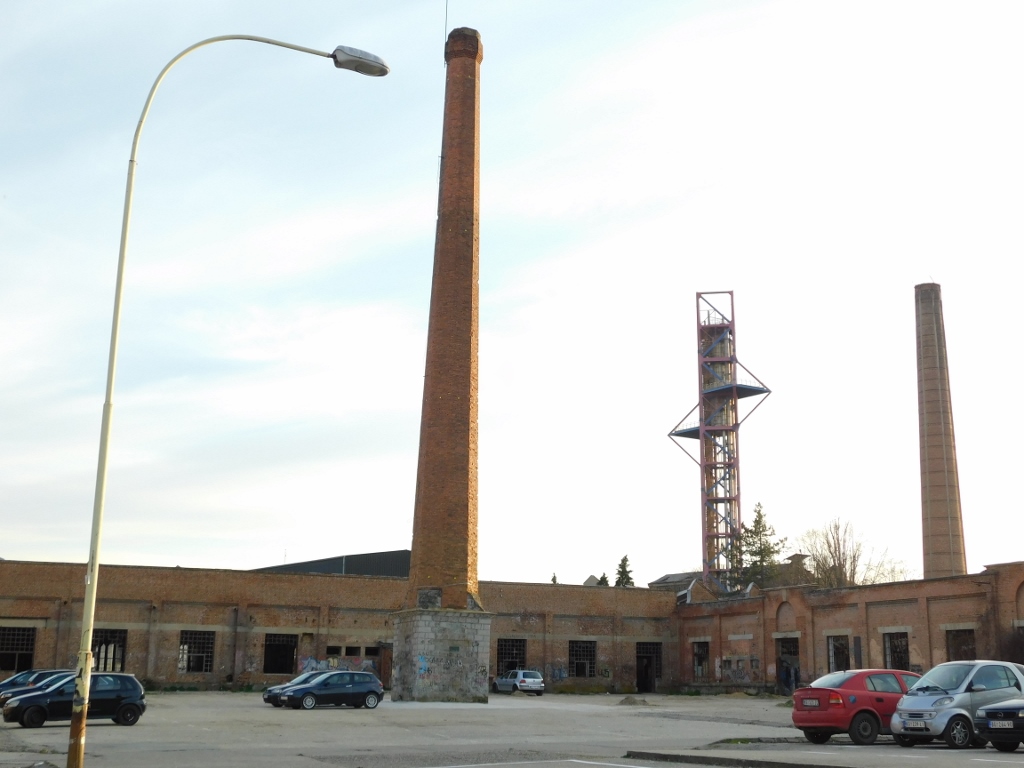 Military and technical institute complex
Military and technical institute complex
Based on a description I have come across, I believe the next photo shows the main (administrative) building, along with the bust of Vojvoda Radomir Putnik (1847-1917), about whom I shared more in the previous part of my stories on the exploration of Kragujevac (see: https://svudapodji.com/en/kragujevac-5/).
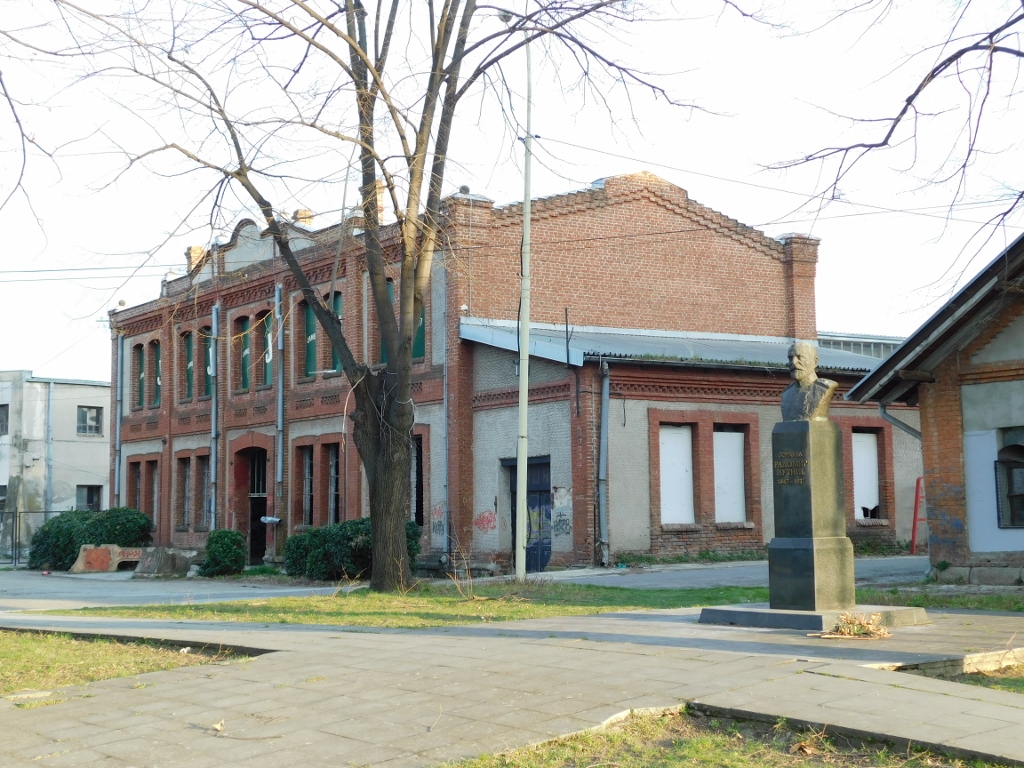 Military and technical institute complex
Military and technical institute complex
But, perhaps the most important building within the complex is the Old Gun Foundry, which itself represents an immovable cultural property of great importance that is listed in the documentation as the “Building of the Foundry with Forge.” The building was constructed between 1851 and 1853 (though there are documents suggesting it was built in 1882). In any case, at the time of its construction, Kragujevac was the most important industrial city in Serbia.
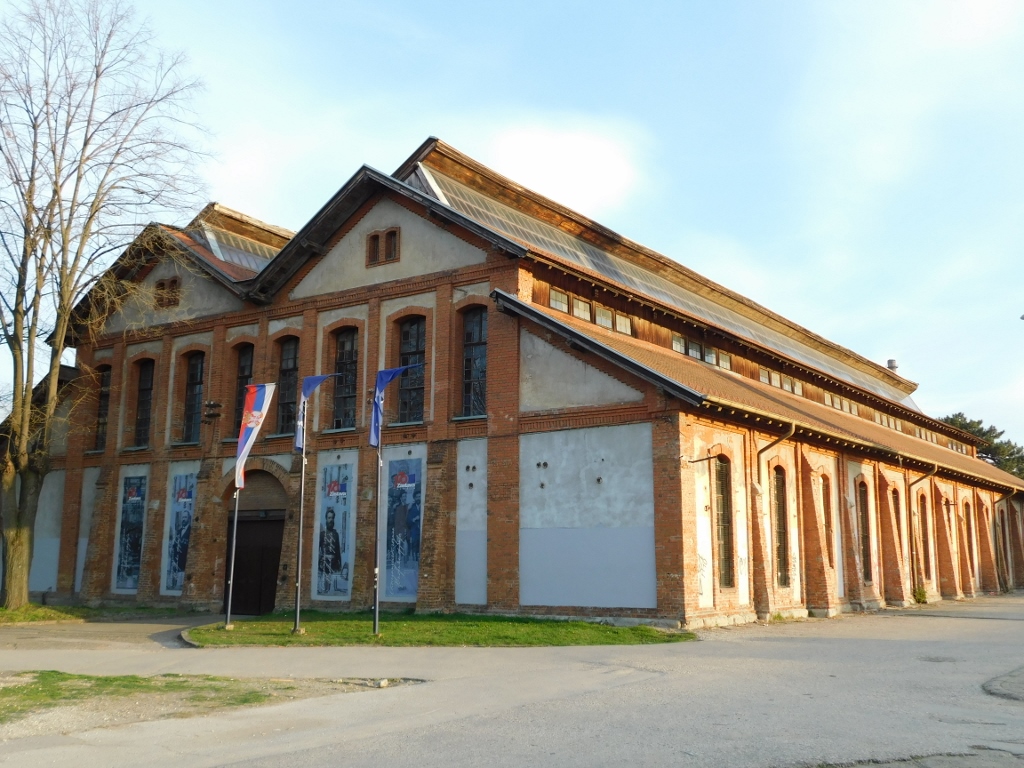 Military and technical institute complex: gun foundry
Military and technical institute complex: gun foundry
This building, located next to a spacious plaza used today as a parking area, also featuring a tall chimney, has recently been superbly renovated and transformed into the Old Gun Foundry Museum. However, as I’ve mentioned earlier, museums in Kragujevac have very inconvenient opening hours. Specifically, this museum is open only on weekdays, from 7 AM to 3 PM, coinciding with the working hours of the “Zastava oružje” factory where this complex is situated.
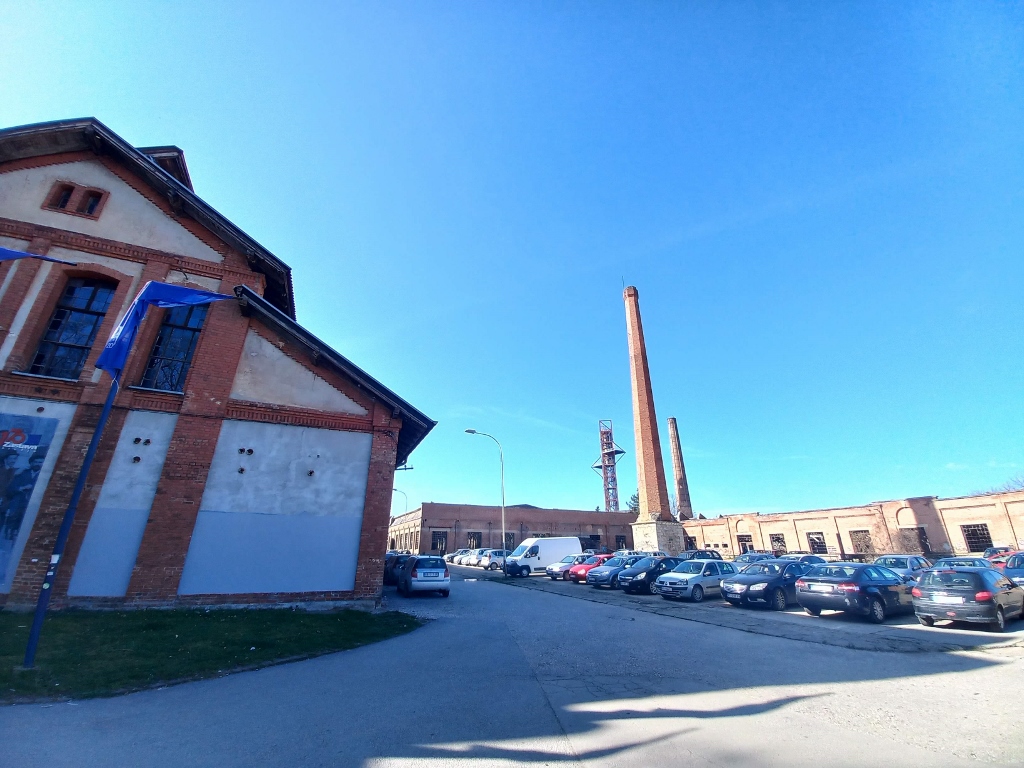 Military and technical institute complex
Military and technical institute complex
Luckily, the clients I worked with in Kragujevac were interested in visiting this museum as well, so we organised a visit early in the morning before our work began. We were greeted by a very friendly woman who also acted as our guide.
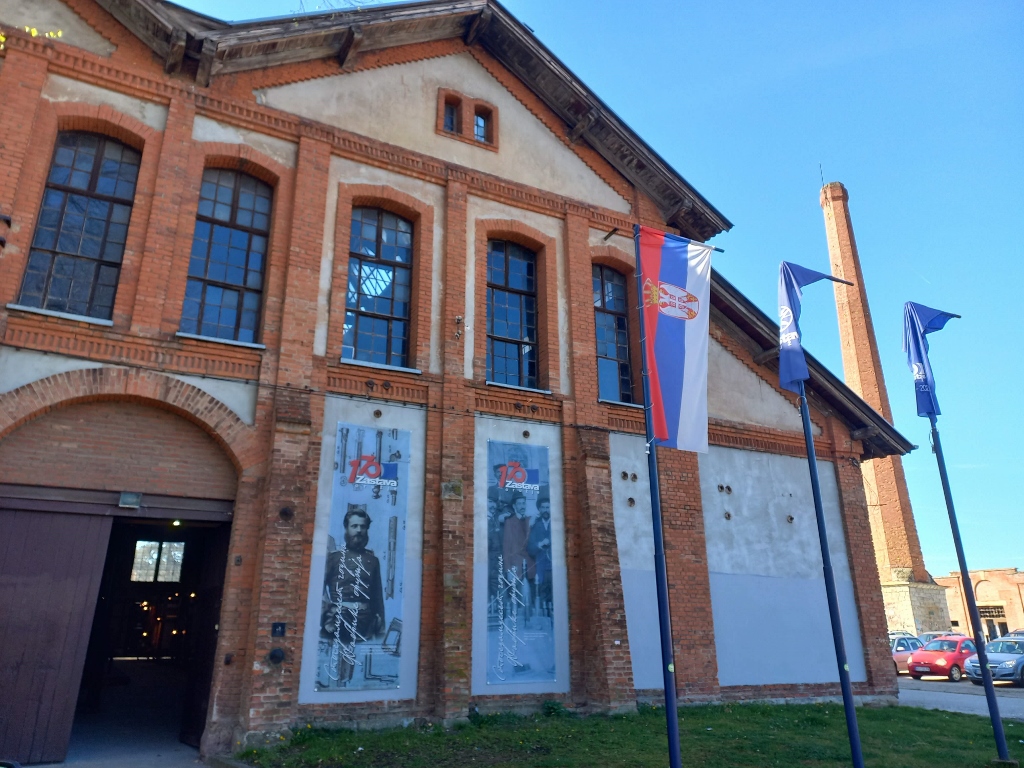 Old Gun Foundry Museum
Old Gun Foundry Museum
Even though I’m not particularly interested in foundries, cannons or weaponry and ammunition, I was absolutely thrilled with this museum. To begin with, it is an extraordinary example of repurposing an industrial architectural structure into a museum in a broader sense. Examples from the world that I have visited include the Tate Modern in London and the Musée d’Orsay in Paris – the former housed in a former power station and the latter in a former railway station. This museum in Kragujevac is much smaller and much less significant on a global scale, but it is still excellent and extremely significant at our national level.
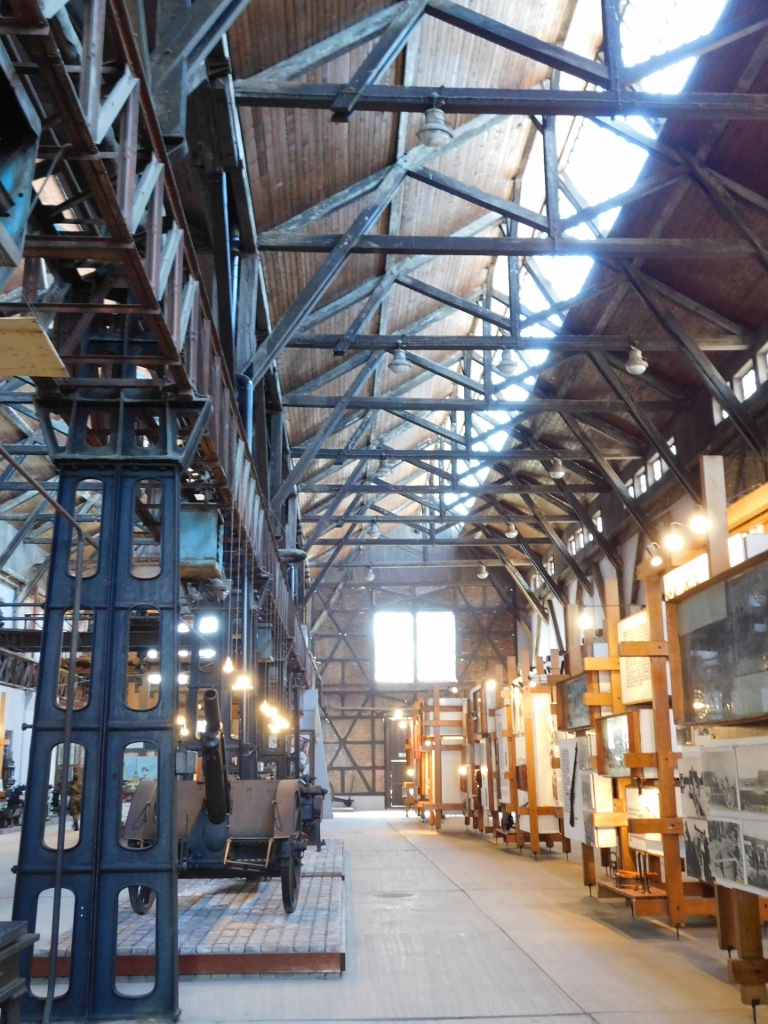 Old Gun Foundry Museum
Old Gun Foundry Museum
Needless to say, I don’t remember everything our guide told us, but it is important to note that the beginning of the foundry’s development is tied to a Frenchman, the first director, who not only founded the facility, but also started the first crafts school because having trained workers and craftsmen was crucial.
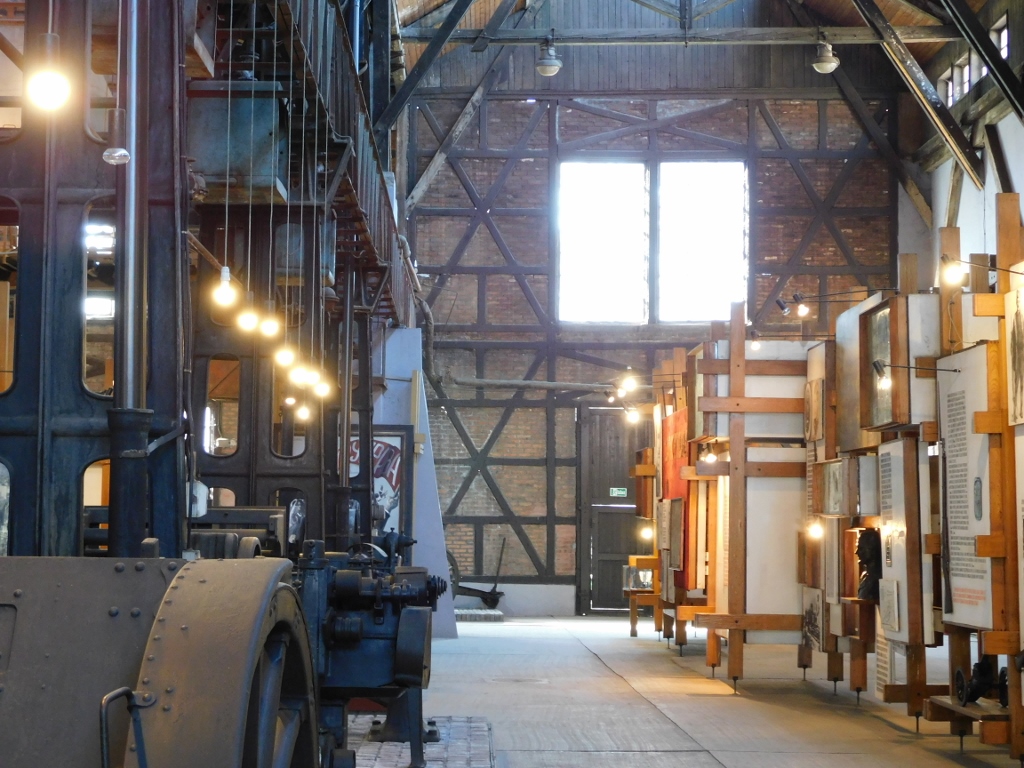 Old Gun Foundry Museum
Old Gun Foundry Museum
Initially, they only repaired weapons and accompanying equipment purchased abroad here, but over time, the manufacturing of original products began as well.
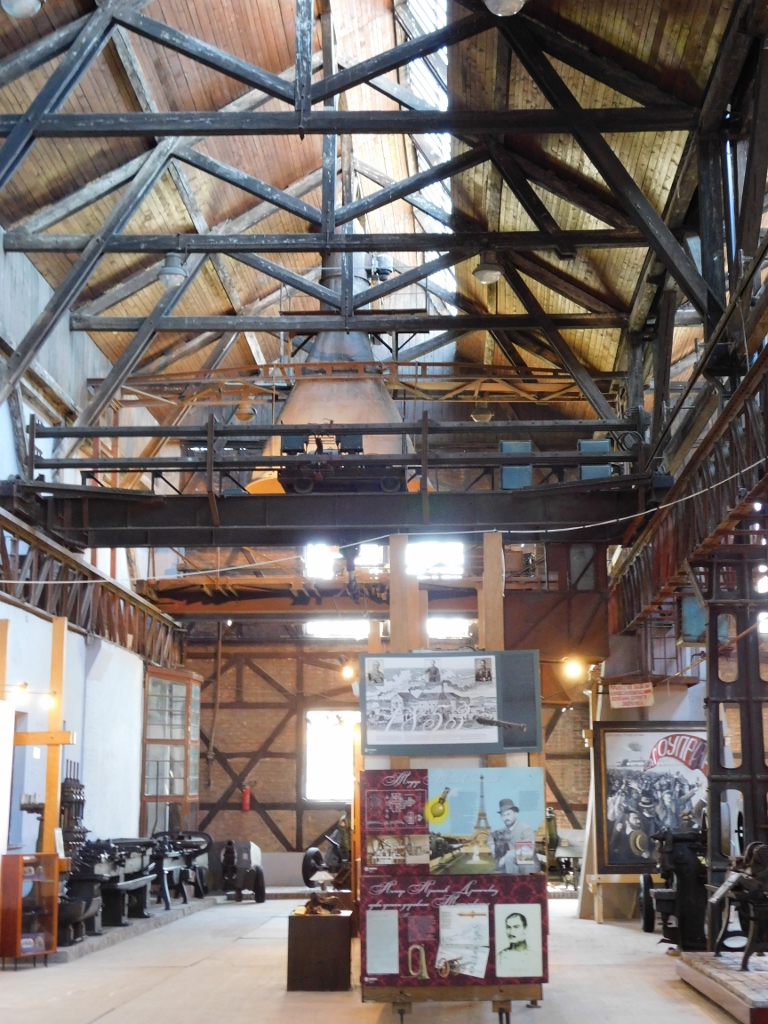 Old Gun Foundry Museum
Old Gun Foundry Museum
 Old Gun Foundry Museum
Old Gun Foundry Museum
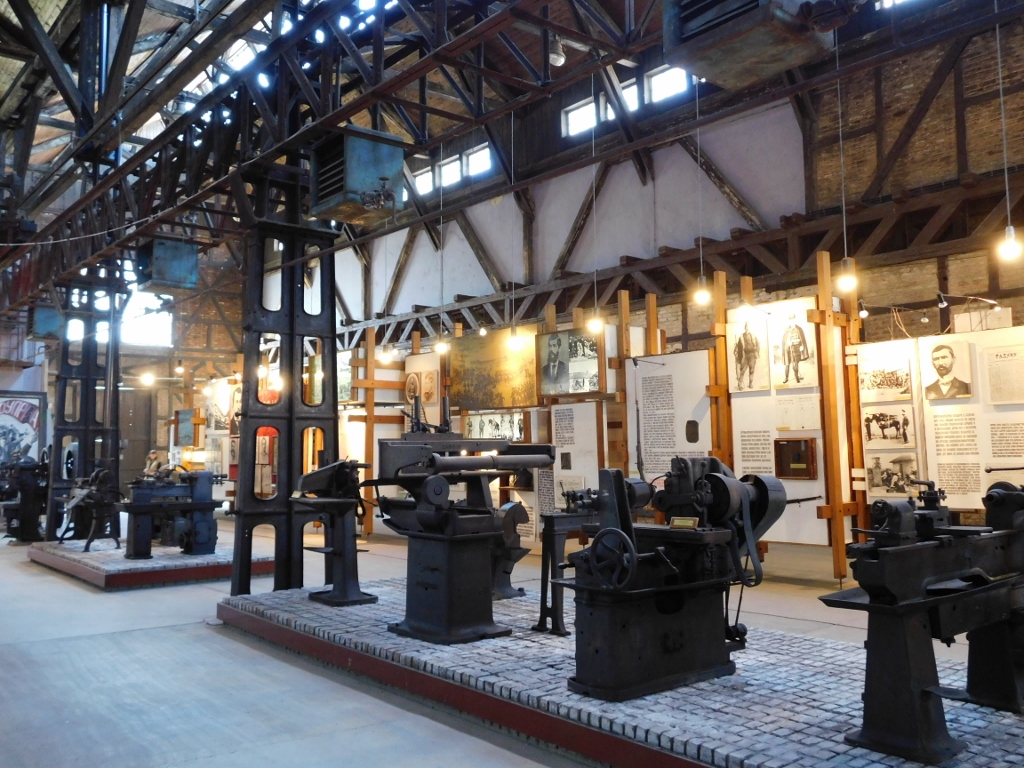 Old Gun Foundry Museum
Old Gun Foundry Museum
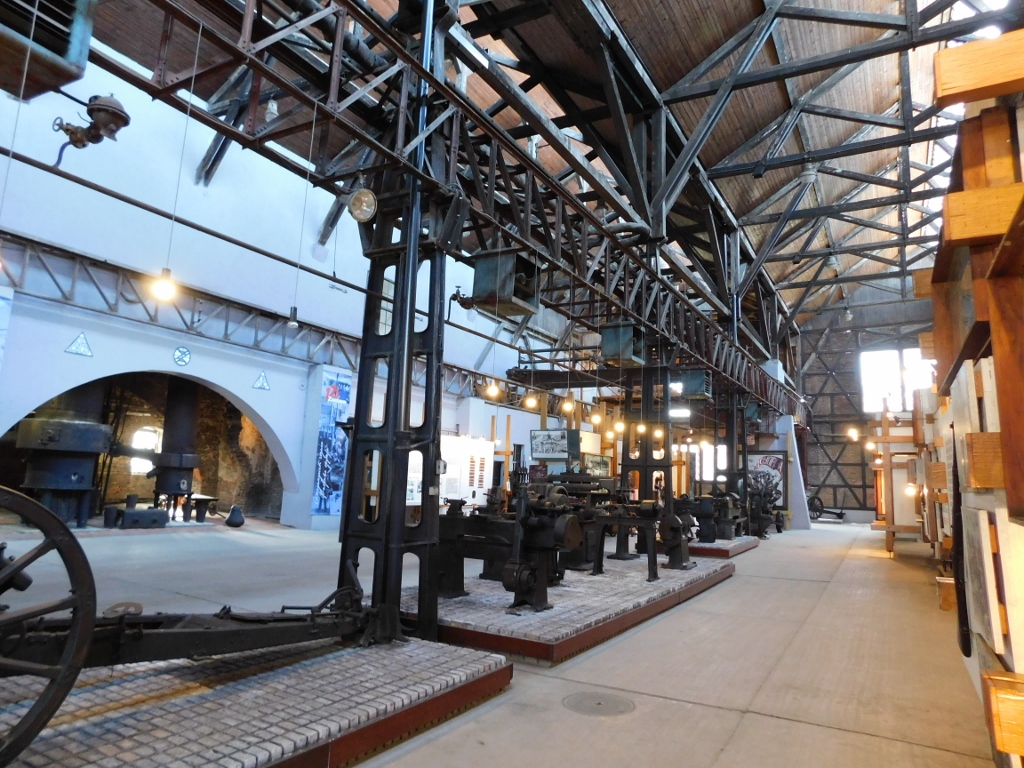 Old Gun Foundry Museum
Old Gun Foundry Museum
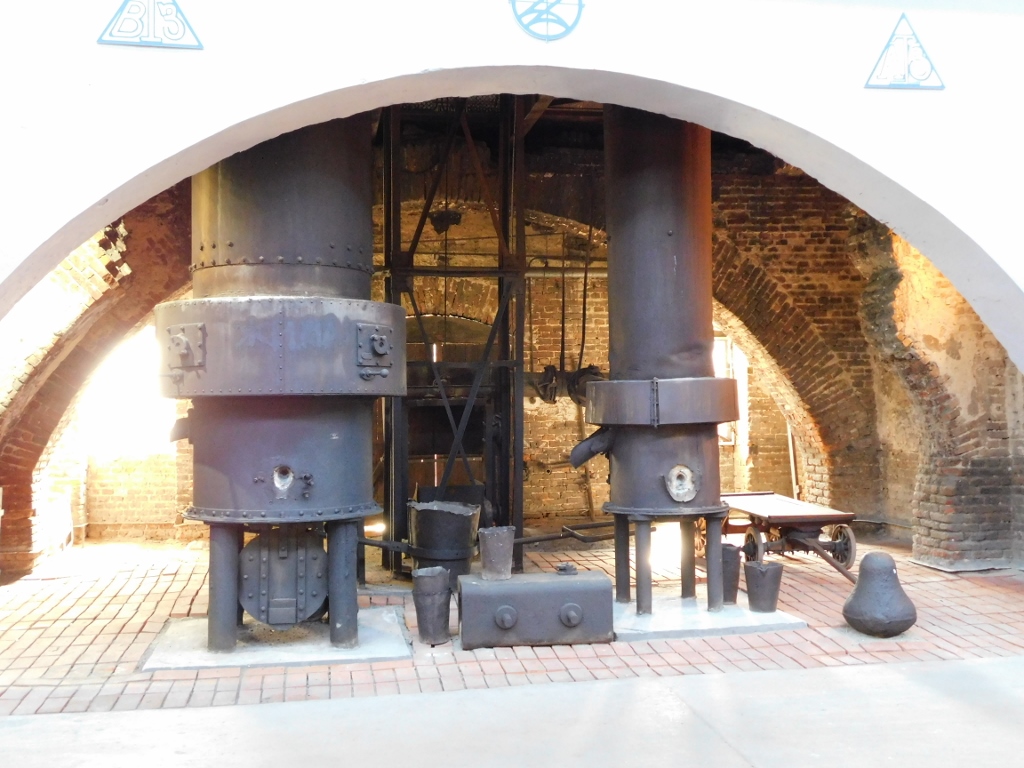 Old Gun Foundry Museum
Old Gun Foundry Museum
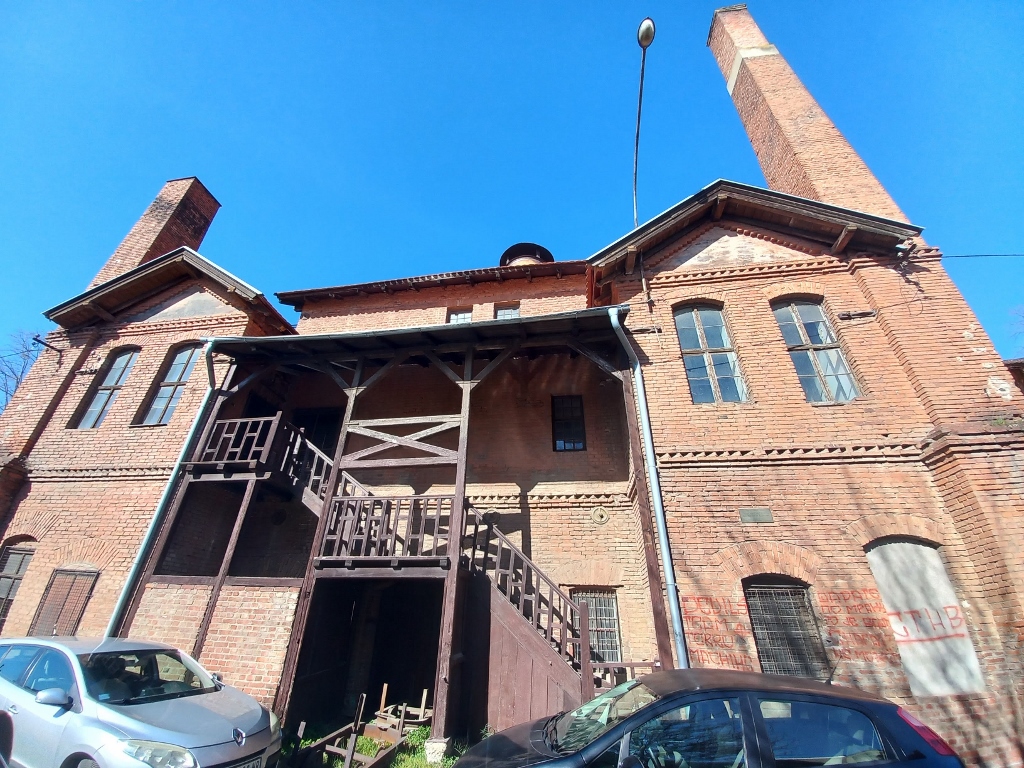 Old Gun Foundry Museum, flanking section where raw materials were delivered
Old Gun Foundry Museum, flanking section where raw materials were delivered
The gun foundry naturally followed the history of the entire nation, experiencing various events during both World War I and World War II, as well as the destruction by Austrians and Germans. A part of the Military and Technical Institute complex was also hit and destroyed during the NATO bombing in 1999.
This museum is truly exceptional and anyone visiting Kragujevac during weekdays until 3 PM should definitely visit this place.
As for me, I have concluded my tour of the monuments on the right bank of the Lepenica River. I continued with my further search for cultural monuments in Kragujevac on the left bank, on the other side of the Arch Bridge no. 1.
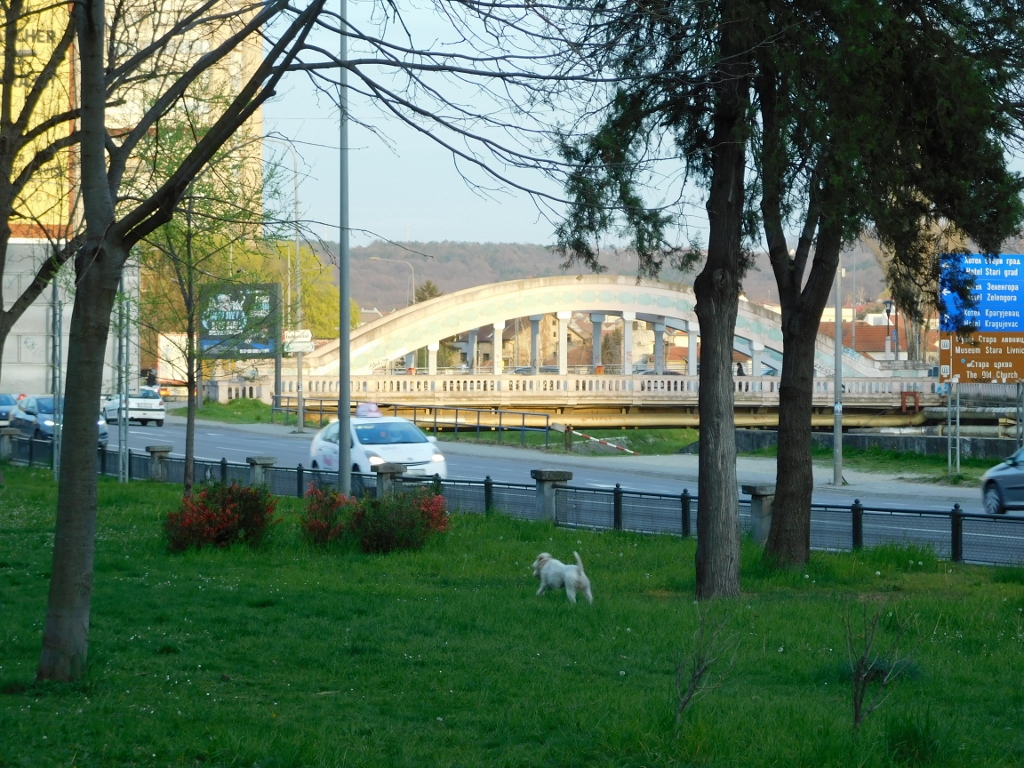 Arch Bridge No. 1 over the Lepenica in Kragujevac
Arch Bridge No. 1 over the Lepenica in Kragujevac